
Employee motivation is a hot topic – and with good reason: A study by Gallup estimates the economic damage of unmotivated employees to be over $450 billion per year – and these are only the figures for the US.[1]
Even more frightening are the statistics that about 70% of all U.S. workers have little or no emotional attachment to their company.
No wonder that companies are actively trying to motivate their employees - because motivated employees with a strong emotional commitment to the company are not only happier, but create real value for the company. Motivated employees with high emotional attachment
- take 41 percent fewer days off; that also means 41 percent less costs through absence,
- stay in the company much longer (resulting in an up to 59 percent lower turnover),
- cause on average 28 percent less depletion,
- are, in comparison, 70 percent less involved in work-related accidents,
- cause 40 percent less quality defects,
- improve customer service KPIs by about 10 percent on average,
- are 20 percent more productive,
- and are responsible for a 21 percent increase in overall profitability.
Note: The 2016 Gallup Meta-Analysis highlighted the differences between employees with high emotional attachment (the upper 25 percent) and lower emotional attachment (the lower 25 percent).
In short: The investment in employee motivation is worthwhile – in multiple ways.
But before we go into the many measures and examples which increase employee motivation, let's take a step back and focus briefly on the following question:
Definition: What is employee motivation?
If we take a look at the definition of motivation, then we only find a somewhat boring explanation of the term motivation:
The condition of a person that causes them to choose a particular course of action to achieve a particular outcome and to ensure that that person maintains their direction and intensity of behavior.
Based on employee motivation, this definition means that employers or executives positively change the condition of their employees through various measures.
In general, a distinction is made between three types of employee motivation: the motivation of employees through material incentives and the intangible employee motivation, as well as the hybrid employee motivation, which is a mix of the first two types.
Motivation of employees through material incentives
This includes, as the name implies, all material incentives for the employee. Examples include:
- Salary
- Bonuses and pensions
- Disability and survivors insurance
- Company cars
- Employee shares in the company
- Other monetary benefits such as job tickets, meal vouchers and other subsidies
Hybrid of material and immaterial employee motivation
This form is not always easy to grasp, because here the boundaries between the two basic forms of employee motivation become blurred. In general, the employee gains a monetary advantage through the measure in question, but also creates a high level of intangible value. Good examples of hybrid types of employee motivation are:
- Sports and leisure activities organised by the employer
- Continuous education, learning opportunities and development programs
- romotion of healthy food in the canteen
- Attractive workplace design
- Company outings
- Spa services
- Home Office regulations
Intangible employee motivation
By contrast, purely intangible employee motivation involves more abstract aspects such as personal growth, trust, relationships with colleagues and supervisors, autonomy, or recognition.
Although these aspects are much harder to grasp and therefore not as easy to influence positively by concrete measures, companies can create the most value through those, and thus also benefit the most from their motivated employees.
In the following, a model is presented that makes the targeted increase in employee motivation easier to understand.
Increasing employee motivation: Theories and methods
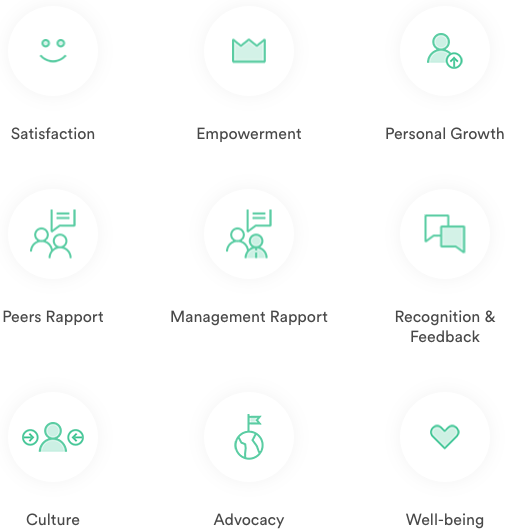
At Honestly, we identified nine elements of Employee Engagement):
- Satisfaction
How satisfied are my employees with regard to compensation, work and additional services? - Empowerment
Will my employees be hampered by a lack of equipment or bureaucracy? Can they make all necessary decisions autonomously? - Personal Growth
Can my employees develop professionally through training courses or mentoring programs? Do my employees see a deeper meaning behind their work? - Peers Rapport
How good is the relationship of my employees with other colleagues? Do my employees trust each other? - Management Rapport
How good is the relationship of my employees with their superiors? Are my employees adequately supported by management? - Recognition & Feedback
How often do my employees receive feedback and provide feedback? Do my employees receive enough recognition? - Culture
Do my employees know the vision, strategy and values of my organisation? How do my employees value the moral sense of responsibility of the employer? - Advocacy
Are my employees proud to work here? Do my employees support the company even in times of crisis? - Well-being
How is the work-life balance of my employees? Is the physical safety of my employees in the workplace guaranteed?
This model makes it possible to identify excellently possible parameters for employee motivation.
Another helpful model to find starting points for motivational measures is the Maslow pyramid of needs.
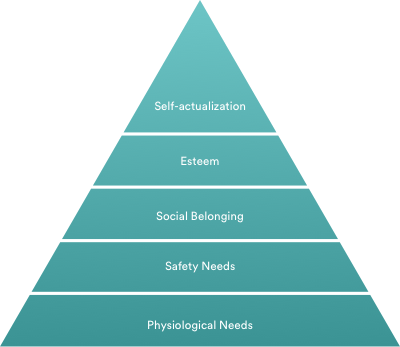
Combined with the model of Honestly this results in:
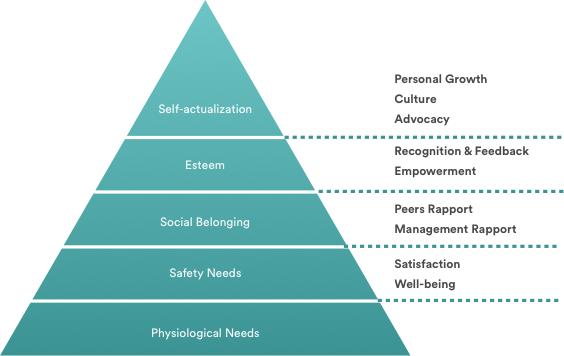
Maslow's theory is that the lower "deficit needs" take precedence over the others. This means that job security or salaries have a higher weighting than, for example, the need for team cohesion. Team cohesion, in turn, takes precedence over training opportunities. The fact is, most companies adequately cover physiological needs and security needs.
But too many companies are relying solely on those factors. Ideally, salaries are also good, but harder-to-grasp concepts such as corporate culture, a shared vision, recognition, and personal growth are often times disregarded or misdirected.
However, there is an undreamt-of potential here, since the intensity of need for cohesion, personal development and meaningful work clearly exceeds the intensity of the basic needs.
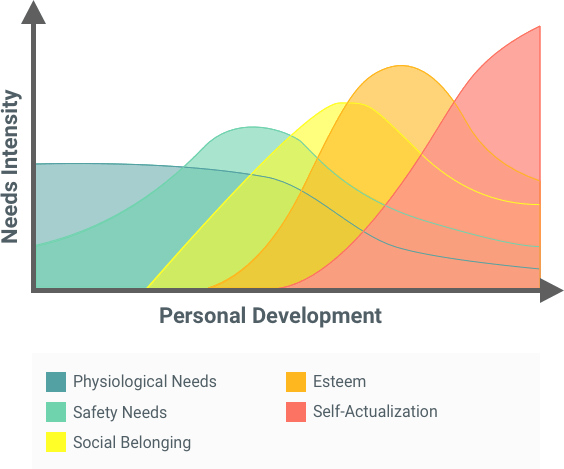
In short: these areas are factors which ensure enthusiasm and the only way you can develop motivated employees with a high emotional commitment to the company.
Increasing the share of highly motivated, emotionally committed and high-performing employees is anything but trivial and requires the support of corporate management as well as continuous measures for employee motivation.
Does this sound like a lot of work? It is! But only in this way one can benefit from the positive effects of motivated employees as outlined in the introduction. And as we have seen, the investment is worthwhile - in every sense.
The theory of Service Profit Chain illustrates the connection between employee satisfaction and the success of a business:[2]
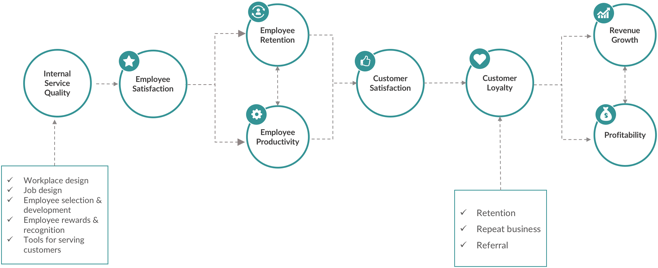
The growth in sales and the profitability of a company are stimulated mainly by customer loyalty. Customer loyalty, in turn, is strongly correlated with customer satisfaction, i.e. the happier your customers are, the likelier they are to become loyal to your business. Customer satisfaction is largely determined by the value or benefit of the services and products offered. In turn, value is created by satisfied, loyal and productive employees. And last but not least, employee satisfaction is primarily driven by the company's so-called internal service quality.
Internal service quality basically means nothing more than the entirety of all measures for establishing employee satisfaction, employee motivation and employee retention. Specifically, the following areas are named in the service profit chain model:
- Workplace Design
- Job specs
- Employee selection and development
- Recognition programs
- Tools for interacting with customers
All of these factors, and more, are also reflected in Honestly's model of actively engaging with employees and creating a bond.
Now that we have the necessary models and understanding of how incredibly important employee motivation is for the success of your business, we will discuss how to take action to drive employee satisfaction, loyalty, and motivation.
Employee motivation: 25 examples
In the following, we will discuss all nine elements of employee motivation and provide concrete examples of how employees can be motivated.
Satisfaction
Aspects of employee satisfaction such as compensation, benefits, and the workplace environment alone are not enough to motivate your employees. The "mere" satisfaction does not spur your employees to peak performance, yet it is the basic requirement to ensure that most employees can strive for something higher (see above the Maslow hierarchy of needs).
1. Fair salaries
This one is easy. One can not impress employees with words alone. We all need money to live. Therefore, ensure that you pay a fair salary so that your employees do not have to worry about this aspect.
However, we advise caution on salary increases: According to a study, no significant correlation could be found between salaries and employee motivation.[3] Rather, some scholars argue that an increase in salaries and other bonuses can even have a mitigating effect on employee motivation.
The reason for this is that there is a natural tension between extrinsic and intrinsic motivation, so that extrinsic incentives such as salary increases lower or even suppress intrinsic motivation, which is much more valuable.
All in all, of course, we do not promote lower salaries, but rather a broader understanding that an increase in salaries is not a panacea and that there are significantly more inexpensive and effective measures for employee motivation.
2. Purchasing a coffee machine
In a nutshell: Coffee makes you productive and happy. If you have many coffee aficionados among your employees (and we bet that you do) then it pays to invest in a premium coffee machine.
Coffee has shown to have an anti-oxidative effect, reducing the risk of cancer and also the risk of heart disease.[4] And as if that was not enough, coffee also has a positive impact on productivity and motivation.
Interestingly enough, it's not just the caffeine it contains that causes increased productivity and employee motivation, but also the coffee break itself. A study has shown that it is mainly the social interactions between employees during coffee breaks that increase employee motivation.[5]
3. Setting up your office in a nice way and keeping it clean

Another no-brainer: If one can spend hours choosing the right color for his living-room curtains, why should one not apply the same basic aesthetic needs to the workplace?
Before you go to the IKEA to purchase new curtains for your office, be aware that different standards apply to offices.
Plants in the office are always a good idea as they do not only visually enhance the office space but also provide oxygen.
Another important point is to tidy up the workplace: starting with the office table, to lounges, the kitchen, toilets and meeting rooms. The Broken Window theory states that even small things such as full bins, a large quantity of unorganised documents and messy toilets can have "devastating" consequences for the overall system (the office and company) by lowering the level of tolerance for such points of neglect.[6]
Finally - if you have sufficient budget available - it always pays off to invest in an entertainment and recreation room, where you can place lounge equipment or ping pong tables.
In short, you can improve the workplace environment with little tricks without having to dig deep into your pocket. Of course, if you have a larger budget on the other hand, you can arrange for complete renovations, such as those at Soundcloud's Berlin office.
4. Jobtickets for your employees
An often overlooked additional benefit: Employers can provide non-monetary and social security benefits for their employees (in Germany up to an amount of 44 euros). Depending on the amount, job tickets can either be taken over completely or subsidised. A small but appreciated gesture for your employees, which is certainly not detrimental to employee motivation.
Empowerment
Employee empowerment includes all the tools that the company can use to help employees reach their full effectiveness and efficiency.
These include:
- Role & Tasks
- Work processes
- Equipment
- Autonomy
- Performance Management
Examples to motivate employees based on empowerment include:
5. Introduction of an OKR system
OKRs (short for Objectives and Key Results) is a goal management framework that has been popularised by Google and has the task of sharpening the focus of each employee, to increase transparency within the company and to facilitate the communication of the corporate strategy.
An OKR includes an objective describing a target to be reached, and several key results, which are essentially measures that determine the progress or achievement of the associated goal.
The method is as simple as it is powerful: well-known companies such as Google, Intel, Oracle, LinkedIn or Twitter have been using it successfully for years and slowly companies from other industries are also beginning to realise that this framework has a large potential to motivate employees and sharpen their focus.
Incidentally, Honestly also owes much of its success to the OKR framework, which has been in use for several years.
6. The equipment of your employees
Self-explanatory: Make sure that your employees do not only have the hardware that is necessary, but also conducive to completing their work. The same applies to the access to software that facilitates the work of your employees. A quick employee survey to ask for missing equipment will save you the guesswork and will give you a direct starting point to make your employees happier and more productive.
Personal growth
Personal growth is probably one of the key factors in employee motivation. In particular, this element of Honestly's Employee Engagement Model addresses the upper spheres of the Hierarchy of Needs. Being able to develop personally and professionally lies in the nature of man and it should not have to be mentioned that employees who want to develop constantly are extremely valuable.
With these examples you can support the personal growth of your employees:
7. Personal education budget
Some companies give their employees a personal education budget that employees can freely dispose of as long as they have a relevant educational intent. This can be used, for example, for seminars, workshops, conferences or e-learning courses.
8. Show and Tells
So-called show and tells are meetings that are arranged on the initiative of one or more employees and in which colleagues can participate voluntarily. The intention behind this form of meeting is to show colleagues interesting insights from the work of the lecturer.
For example, an HR employee could explain the onboarding process to a new employee or a marketing colleague could present the branding guide to the company. There are no limits to this show and tells.
Typically, show and tell meetings take place on a Friday afternoon or just after lunch and last 15-30 minutes. Of course, the format can be adapted to your own wishes.
These self-organised "employee seminars" are a very effective and also free tool to bring domain knowledge into other departments and to promote the personal development of all employees – which has a tremendous impact on employee motivation.
9. Set up mentoring programs
Mentor programs are effective for three main reasons:
- The mentee has a much steeper learning curve than if she had to learn everything herself
- The mentor has the opportunity to develop leadership skills and to consolidate her knowledge through articulation of her activity
- The mentor-mentee relationship promotes social interaction within the company, which can even help to establish friendships between employees
Peers Rapport
10. Team Lunch
Depending on the size of the company, it may be useful to set up lunch once a week with the team for which the company pays. But even for larger companies such a ritual can be easily implemented by teams from the individual departments.
If you can find a way to "break down barriers" between departments by creating a system that includes all departments in the team lunch, you've just taken a valuable step toward employee cohesion and employee motivation.
11. Team Events
By team events, we are not only talking about compulsory Christmas parties, but regular company outings with the staff to strengthen cohesion.
But company outings usually require a lot of planning, so we recommend - without much fuss - to plan weekend activities for for your employees. The frequency of interacting with colleagues outside work, in a normal private environment, is far more important than any pompous Christmas party.
And best of all, true cohesion among colleagues promotes the emergence of friendships, which according to studies leads to greater productivity and motivation in the workplace.[7]
Management Rapport
12. One-on-one meetings with supervisors
This example of how to increase employee motivation is likely familiar to you. Regular one-on-one meetings with the manager are one of the most important tools for giving feedback to employees and improving the relationship between supervisors and employees.
Recognition & Feedback
The supreme discipline of employee motivation: Recognising achievements and developing a healthy feedback culture are the building blocks for an open, motivated and productive feeling of togetherness. (We are so convinced of this that we have designed our own feedback solution to increase employee retention.)
13. Giving praise - but in the right manner
You can not go wrong with praise, you might think. Unfortunately however, you can. You should keep in mind a few basic rules before praising your employees:
- Praise should not be used inflationary - otherwise it loses its motivating effect
- Praise should be authentic and serious
- Praise should always be specific and not generic - only relevant praise is useful for the employee
As soon as you follow these rules, praising employees, probably one of the best instruments of all of those mentioned, motivates employees in the long term.
Spontaneous and concrete praise is one measure to convey a sense of appreciation. However, the recognition of an employee can also be expressed non-verbally and at a subliminal level, for example by the general attitude and behavior towards the employee. This form of recognition affects the overall image of the employee and is therefore more difficult to grasp - the employee, however, usually feels whether she receives recognition or not.
14. Pulse surveys - feedback from employees
Feedback is the linchpin of good internal communication. There are hundreds of instructions on how to conduct a feedback interview with employees. But most of the time, feedback is given to employees only in the context of employee appraisal interviews, what he or she does well, and what can be done better.
Rarely does the employee have the opportunity to provide feedback to superiors, colleagues or the corporate culture. But employee feedback is an invaluable asset as it provides you with concrete starting points for sustainably improving your corporate culture, retaining your employees and attracting new talent. For this reason, there are tools such as Honestly, with which continuous employee surveys can be realised – on autopilot.
Culture
"We are one firm, defined by our unwavering commitment to our clients, our shareholders, and each other. Our mission is to build unrivaled partnerships with and value for our clients, through the knowledge, creativity, and dedication of our people, leading to superior returns to our shareholders." – Lehman Brothers
This mission statement was featured on the website of Lehman Brothers, the notorious US investment bank whose bankruptcy was primarily responsible for the global financial crisis. It has become a relic of capitalism.
In a nutshell: Most of the mission statements and corporate values are hollow words. This has devastating consequences for the company: A healthy corporate culture that builds on authentic company values creates transparency, a sense of belonging and accelerates decision-making processes.
The larger the company and the more employees the company has, the more difficult internal communications and the more complex bureaucratic processes become. If you have a working corporate culture, then your employees speak "one language" and can refer to corporate values in tricky decisions. The result are motivated employees who can identify themselves with their employer and the elimination of decelerating bureaucracy.
A corporate culture can not be created. The corporate culture is always there. But it is up to you to shape the culture and to steer it in the right direction.
Two examples to shape the corporate culture and to motivate employees:
15. Introducing an error culture
Mistakes should be allowed. To be precise, mistakes should even be desirable – because only through trial and error can we grow as human beings. At the same time we learn to deal with setbacks and learn to decouple mistakes from the negative concept of defeat. Our world is increasingly fast-paced and complex, which requires a new level of experimentation.
Move fast and break things. Unless you are breaking stuff, you are not moving fast enough. – Mark Zuckerberg, Facebook
An example to introduce an error culture are so-called fuckup nights. In this relaxed and often funny format, employees (including management) present their biggest "fuckups" – this does not only have the effect of allowing colleagues to learn from others' mistakes, but also strengthens the collective feeling by being able to talk openly about mistakes.
16. Kickstart-Mondays
On Monday mornings, team members gather and talk about their successes in the last week - no matter how big or small. This will start the working week directly with a sense of collective positive energy.
17. Offsite events with the company
An offsite event or meeting is an event that is deliberately held outside the office. These are perfect for pondering with the whole team on the formative values of the company and bringing about a concrete formulation of the same – this creates transparency and cohesion.
Depending on the size of the company, it may not be practical to gather all employees at an offsite event. In this case, theoretically, individual offsite events can be held, which converge together in the formulation of corporate values.
18. Supporting charity projects
Show your employees that their employer is aware of their social responsibility. Ideally, the charity project is directly linked to your corporate mission.
Advocacy
Advocacy measures how proud the employees are of their employer, how they represent the company externally, and whether they show loyalty to the company in times of crisis.
19. Merchandise for employees
T-shirts, polo shirts, hoodies, and other merchandise items are just a few examples of how employee motivation can be achieved by creating a sense of belonging. Corporate logo T-shirts are usually worn for sleeping only, but when these T-shirts fall into the hands of motivated and proud employees, this can be an effective employer branding tool.
Well-being
The physical and mental well-being of your employees is the foundation on which the quest for self-fulfillment and meaningful work is based. Therefore, pay close attention to the stress level, the work-life balance and the health of your employees.
There are numerous examples of how you can motivate your employees:
20. Flexible working hours
Every person has different rhythms. Trust in the principle of self-organisation and give your employees more flexibility in their working hours.
21. Homeoffice
Opinions differ on this aspect: On the one hand, you want to enable your employees to harmonise work and private life as smoothly as possible. On the other hand, it is very difficult to integrate absent employees, who often work from home, into the corporate culture. Both arguments are valid, which is why we believe that the home office should have a firm place in the modern working world – but in moderation.
Specifically, this means that you could declare a fixed day of the week as a home office day, or generally allow employees to work from home, but only under special circumstances (such as relocation or medical appointments).
22. Fruit baskets and healthy snacks
Promote a healthy diet by always providing plenty of healthy fruit.
23. Yoga classes and other sports activities
To promote the physical health of your employees, you could offer a gym membership or even offer classes in-house.
24. Napping Station or meditation room
If you want to give your employees pure wellness luxury, you could even set up your own space just for powernaps or meditation exercises – a haven for those in need of some rest and re-energising for the rest of their working day.
25. Introducing six-hour days
This is certainly one of the more controversial examples of employee motivation. In Sweden, a large six-hour day field experiment was performed, which had a significant positive impact on participants' stress levels, but was discontinued after two years due to high costs.
Nevertheless, we believe that the conventional eight-hour day will become obsolete in the not-too-distant future through technological advances and increasing automation.
More examples of employee motivation can be found on our blog.
Measuring employee motivation - but how?
Measuring employee satisfaction and employee motivation provides useful information about the status quo in your company while providing concrete starting points for improving it.
The traditional way are annual or even biennial employee surveys. However, these traditional employee surveys are, in our view, completely outdated.
The main disadvantages of employee surveys are listed here:
- When measuring through annual employee surveys, a lot of feedback is lost
- The company can only react very slowly to feedback
- The rest of the year you are "blind" to feedback and suggestions for improvement
For this reason, Honestly, in collaboration with clients such as Daimler and Lufthansa, has developed an employee feedback solution that measures the above-mentioned areas of employee engagement in any number of adjustable turn cycles (weekly or monthly, for example).
The benefits of measuring employee motivation through continuous pulse interviews are obvious:
- You can see in which areas you have room for improvement and can react immediately instead of waiting for longer periods
- You can analyse how areas like e.g. employee satisfaction or work-life balance change over time
- The response rate is usually very high, as smaller questionnaires are sent, which can be answered in one to two minutes
Questionnaire for employee motivation
Here is a template for a questionnaire that measures employee motivation and employee satisfaction.
Excursus: Change Management and Employee Motivation
Change management refers to the entirety of all measures required to bring about a far-reaching change - in terms of strategy, processes, behavior, structures and systems - in the organisation.
Change management projects mark a significant intervention (even if well meant) in existing structures and the daily lives of employees. For this reason, such projects fail with impressive frequency: According to the change management researcher John P. Kotter about 70 percent of change management projects fail.
So there must be a concerted approach to introduce change processes harmoniously and thoughtfully, without demotivating the workforce.
Kotter has introduced the 8-step model for this, in order to drive forward changes carefully and ultimately successfully.
1. Communicating the urgency for change
This involves raising awareness of the urgency of both managers / executives and employees. For example, post-mortem analyses, the development of scenarios, or company-wide meetings that emphasise the urgency of the changes, are helpful.
2. Building a leadership coalition
To drive change, you need a team of people who fully support the change management project, are able to represent the relevant departments, and ideally have sufficient responsibility and authority to bypass bureaucratic blockages.
3. Developing a vision and strategy
Employees are more easily motivated to change if the employer can present a clear vision and strategy. The vision serves as a memorable image that gives more depth to abstract terms such as "change management project" and process of change and thus promotes acceptance.
Finally, the development of a well-thought-out strategy represents the argumentative course and the time course of the project. This, too, leads to a higher level of acceptance among the employees, since transparency is created and the changes are linked with logical arguments.
4. Communicating a clear vision
Do not inform your employees about the vision through a taciturn newsletter. The vision should be heard and lived everywhere – so think of a platform to transport the vision to each employee.
5. Removing obstacles along the way
Identify possible blockages that hinder change with your project team and look for ways to resolve them.
6. Making short-term success visible
At the beginning of the project, define milestones for small achievements that can be communicated. This creates acceptance, positive energy and the necessary momentum to successfully complete the project.
7. Continuing to drive change
The momentum of the project must always be maintained so that it is not interrupted along the way. To do so, you should always document and share all achievements and milestones with direct stakeholders (or even with the entire company).
8. Anchoring changes in the corporate culture
The process of change is completed at some point. Now it is necessary to "freeze" the change and anchor it firmly in the corporate culture. To this end, the changed state must be kept intact by stabilising measures until it becomes a habit and a complete and lasting integration into the overall system takes place.
Conclusion
Internal communication is the determining pivot of the entire change process. To maintain employee motivation in the context of change management, you should therefore follow the Kotter model meticulously.
Summary: How to Implement Employee Motivation Measures
By the end of this guide to employee motivation, you should have developed a deeper understanding of motivation and a more accurate idea of how deeply motivated and emotionally engaged employees impact company performance.
With this guide, you'll also have a repertoire of specific and actionable examples to increase employee motivation, which you can access as soon as you know where the issue lies.
In order to identify the underlying issues of employees, it is necessary to measure employee motivation and to analyse employee satisfaction in all areas.
This is exactly where Honestly comes in with its employee engagement solution.
Check out Honestly in a free Live Demo:
- https://news.gallup.com/businessjournal/162953/tackle-employees-stagnating-engagement.aspxreturn
- https://hbr.org/2008/07/putting-the-service-profit-chain-to-work return
- http://www.timothy-judge.com/Judge,%20Piccolo,%20Podsakoff,%20et%20al.%20%28JVB%202010%29.pdf return
- https://www.bmj.com/content/360/bmj.k194 return
- https://papers.ssrn.com/sol3/papers.cfm?abstract_id=1586375 return
- https://hbr.org/2005/04/sweat-the-small-stuff return
- https://hbr.org/2017/05/work-friends-make-us-more-productive-except-when-they-stress-us-out return

